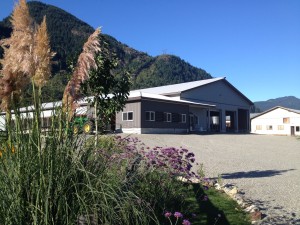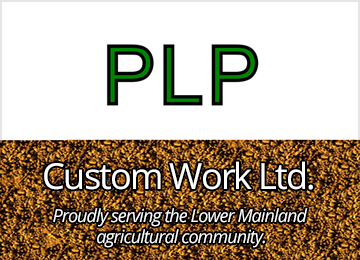Julaine Treur
Since announcing our plans to transition to organic farming nearly three years ago, my husband and I have heard many assumptions about this type of farming. When talking about our plans, it wasn’t uncommon to hear these types of responses: “The only difference between conventional and organic farming is that organic farmers spray chemicals at night.” or, “Organic? Are you sure? Your fields will soon be overrun with weeds and crop disease!” or, “Organic farmers aren’t allowed to use antibiotics, so instead of treating sick cattle, they leave them to suffer and die.” To us, these responses emphasized the lack of knowledge about the organic way of farming; and it seems this type of mindset is quite prevalent throughout the agricultural community.
Approximately two and half years ago, during a conversation with an organic dairy farmer friend, we were told about the demand for organic milk products, the opportunities for growth in the organic sector and the premium paid to organic dairy farmers. This conversation prompted us to seriously think about transitioning to this type of farming. After all, we already employed numerous organic practices: our cows were on pasture during the summer months, our cows were not fed large quantities of grain, and our antibiotic and fertility drug use was quite low. We researched the organic system and found that although the transition would be labour intensive and time consuming, it was a challenge we couldn’t resist accepting. Our decision was originally made for mostly economic reasons but has transformed into a firm belief in the organic system’s merits.
So what does “organic” actually mean and how does it apply to dairy farming?
Officially, the word “organic” refers to the way agricultural products are grown and processed. Consumers can be assured that organic food is produced using environmentally and animal-friendly farming methods. Organic certification tells the consumer that the product they purchase has been inspected and verified to have been produced and processed according to the Canadian Organic Standard. This standard is every organic farmer’s bible. It details the required production methods for any type of crop or livestock, and includes a list of Permitted Substances for use in organic farming (e.g. manure, compost, vitamins and minerals, etc.). In organic dairying, both the crops grown and the livestock that are raised and milked must be certified to have been grown and managed according to the standard. The main differences between organic and conventional dairying can be divided into two categories: crops and cattle.
Crops:
- No chemical fertilizer use permitted. We use a combination of cow manure and composted chicken manure to fertilize our crops.
- No synthetic pesticide use permitted. Instead of using herbicides to control weeds, we utilize mechanical cultivation techniques and crop rotation to minimize weed spread and growth. Our corn crop is seeded later than usual (early June) to minimize wire worm problems. Wire worms move deeper into the soil as the soil warms, so seeding in June helps to prevent loss of corn plants to this pest, as well as ensuring that the corn grows quickly and doesn’t become choked out due to weed growth.
- Crop rotation and cover crop seeding/mulching/integrating into the soil are integral parts of an organic farm plan.
Cattle:
- Must be fed 100% certified organic feed (GMO free).
- Must have access to pasture during the growing season.
- Must gain 30% of their forage intake (dry matter basis) from grazing during the growing season.
- Must have access to a walkout area during the winter months and if pasture is inaccessible due to inclement weather during growing season.
- Can only be treated with health care aids listed in the Permitted Substances List.
- If approved health care aids fail and other drugs must be used, milk withdrawal is one month or twice as long as the labeled withdrawal period, whichever is longer.
- A cow can only be treated with antibiotics twice in one year before losing organic status.
- Organic farms in BC must also adhere to the Code of Care for the Handling of Dairy Cattle (which is mandatory for all dairy farms in BC this year). The Organic Standard’s guidelines and rules with regards to the care and handling of dairy cattle are at least equal to, and, in some cases, more strict than the Code.
Organic Certification Process
A farmer wishing to transition to organic must first become certified by an accredited certifying body. The certifying body collects all of the farm’s information including a detailed list of land history and which inputs have been used in the past; soil and water tests; a farm plan describing all crops and livestock grown on farm, crop rotation plans, and pest management plans; field maps; water, soil and crop sample tests; livestock density charts; pasture log, and herd treatment records etc.
The initial application process is complicated and time consuming; subsequent yearly applications are much more streamlined and less labour intensive. Next, the certifying body arranges for the farm to be inspected by an independent verification officer. The verification officer visits the farm, inspects all fields and crops, livestock, and farm buildings and then meticulously combs over and audits the farms production records, input records, sales receipts, invoices, etc. Once the verification officer has finished the inspection, s/he prepares a report for the certifying body, identifying any problems or areas where the farm is non-compliant to the Standard, or any areas where the farm has an Opportunity for Improvement (OFI); and, finally, recommends whether the farm is eligible for certification. This process is repeated at least once a year; each farm is inspected once yearly with the possibility of extra unannounced inspections.
Land to be included in the organic farm plan must be managed according to the standard for three years before being certified organic. Our land is currently in its third year of organic management, which means it has T3 status. The last prohibited substance (chemical fertilizer) was applied to our land in August 2012. Our land will be certified organic August fifteenth of this year.
 Cows beings transitioned to organic must be managed organically for a minimum of one year before the milk they produce is considered organic. Many farms considering changing to organic milk production choose to sell their herd and start over with certified organic cows, eliminating the need for a transitional period. We chose another route, preferring to retain our crossbred cows and heifers; therefore, starting November 1, 2014, we began transitioning our herd to organic. During the herd transition year, farm raised crops can be fed to the cows. The first nine months of the transition, they must be fed a minimum of 80% organic/farm raised feed, with 20% conventional feed permitted. The final three months, all feed must be organic/farm raised. As soon as the herd is fully certified, all crops fed must be organic (no T3 feed permitted). After this lengthy land and herd transition, we’ll certainly be pleased to see the organic milk truck loading our first tank of organic milk in November!
Cows beings transitioned to organic must be managed organically for a minimum of one year before the milk they produce is considered organic. Many farms considering changing to organic milk production choose to sell their herd and start over with certified organic cows, eliminating the need for a transitional period. We chose another route, preferring to retain our crossbred cows and heifers; therefore, starting November 1, 2014, we began transitioning our herd to organic. During the herd transition year, farm raised crops can be fed to the cows. The first nine months of the transition, they must be fed a minimum of 80% organic/farm raised feed, with 20% conventional feed permitted. The final three months, all feed must be organic/farm raised. As soon as the herd is fully certified, all crops fed must be organic (no T3 feed permitted). After this lengthy land and herd transition, we’ll certainly be pleased to see the organic milk truck loading our first tank of organic milk in November!
We feel a sense of pride and accomplishment resulting from our efforts to farm sustainably, utilizing environmentally friendly, traditional farming practices, while providing consumers with the opportunity to choose foods that best align with their personal choices and ideals. Although the organic way of farming is a good fit for our family and farm, this is not true for all farms—neither should it be. Farmers who choose to farm as we formerly did are also good stewards of the land, provide excellent care for their animals, and are great examples of the types of people needed to feed the world. Up until this point, we are pleased with our decision, and, as we travel further on this organic journey, we’re excited to see what the future has in store for our cows and our family!
For more great stories from MODERN AGRICULTURE, you must SUBSCRIBE and be a part of our tribe! FREE issues to your door!
[infobox title=’Julaine Treur’] Together with her husband Johannes, Julaine Treur owns and operates a transitional organic dairy farm in Agassiz, BC. Firmly committed to transparency in the dairy industry, Julaine regularly shares photos and stories of their farming life on social media. Her posts can be found on Facebook (Creekside-Dairy), Twitter (@creeksidedairy) and blog (www.inuddernews.com).[/infobox]
Together with her husband Johannes, Julaine Treur owns and operates a transitional organic dairy farm in Agassiz, BC. Firmly committed to transparency in the dairy industry, Julaine regularly shares photos and stories of their farming life on social media. Her posts can be found on Facebook (Creekside-Dairy), Twitter (@creeksidedairy) and blog (www.inuddernews.com).[/infobox]












